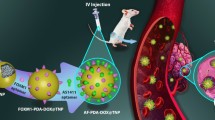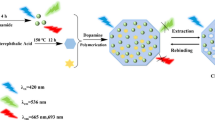Abstract
Despite black phosphorous (BP) QDs possess the merits of size-tunable band-gap, high electron mobility, and intrinsic defects, the spontaneous agglomeration and rapid oxidation of BP QDs in aqueous solution caused low electrochemiluminescence (ECL) efficiency and unstable ECL signal, which confined its further application of biological analysis. Herein, polyethylene glycol–functionalized BP QDs (PEG@BP QDs) were prepared showing an efficient and stable ECL response, which is attributed to the fact that PEG as protectant not only effectively prevented the spontaneous agglomeration, but also restrained the rapid oxidation of BP QDs in aqueous solution. As proof-of-concept, PEG@BP QDs were used as an efficient ECL emitter to combine with palindrome amplification–induced DNA walker to construct a sensitive ECL aptasensing platform for detecting cancer marker mucin 1 (MUC1). Interestingly, with the aid of positively charged thiolated PEG, the reaction rate of DNA walker on the electrode interface was clearly increased for the recovery of the ECL signal. The ECL aptasensor provides sensitive determination with the detection limit of 16.5 fg/mL. The proposed strategy paves a path for the development of efficient and stable ECL nanomaterials to construct biosensors for biosensing and clinical diagnosis.
Graphical Abstract










Similar content being viewed by others
References
Giaquinto AN, Sung H, Miller KD, Kramer JL, Newman LA, Minihan A, Jemal A, Siegel RL (2022) Breast cancer statistics, 2022. Ca-Cancer J Clin 72(6):524–541
Tang YH, Tian WW, Xie JD, Zou YT, Wang ZH, Li N, Zeng Y, Wu LY, Zhang Y, Wu S, Xie XM, Yang L (2022) Prognosis and dissection of immunosuppressive microenvironment in breast cancer based on fatty acid metabolism-related signature. Front Immunol 13:843515
Durham DD, Abraham LA, Roberts MC, Khan CP, Smith RA, Kerlikowske K, Miglioretti DL (2022) Breast cancer incidence among women with a family history of breast cancer by relative’s age at diagnosis. Cancer 128(24):4232–4240
Song ZH, Zhou Y, Shen MZ, Zhao D, Hu HH, Zeng S, Sun LL, Cai S (2022) MUC1 detection and in situ imaging method based on aptamer conformational switch and hybridization chain reaction. Talanta 239:123129
Pang Z, Dong XR, Deng HY, Wang CZ, Liao XD, Liao CH, Liao YH, Tian WD, Cheng JK, Chen GQ, Yi HY, Huang L (2022) MUC1 triggers lineage plasticity of Her2 positive mammary tumors. Oncogene 41(22):3064–3078
Wu G, Kim D, Kim JN, Park S, Maharjan S, Koh H, Moon K, Lee Y, Kwon HJ (2017) A mucin1 C-terminal subunit-directed monoclonal antibody targets overexpressed mucin1 in breast cancer. Theranostics 8(1):78–91
Weaver S, Mohammadi MH, Nakatsuka N (2023) Aptamer-functionalized capacitive biosensors. Biosens Bioelectron 224(15):115014
Shen PY, Jang K, Cai ZY, Zhang YQ, Asher SA (2022) Aptamer-functionalized 2D photonic crystal hydrogels for detection of adenosine. Microchim Acta 189:418
Yousef H, Liu Y, Zheng LX (2022) Nanomaterial-based label-free electrochemical aptasensors for the detection of thrombin. Biosensors-Basel 12(4):253
Wang LJ, Zhou H, Hu HX, Wang Q, Chen XG (2022) Regulation mechanism of ssDNA aptamer in nanozymes and application of nanozyme-based aptasensors in food safety. Foods 11(4):544
Lei Z, Lei P, Guo JF, Wang ZX (2022) Recent advances in nanomaterials-based optical and electrochemical aptasensors for detection of cyanotoxins. Talanta 248:123607
Tong JJ, Cao Y, Zhang YW, Wang P, Wang PL, Liao XJ, Zhang WG, Wang Y, Zheng YX, Zhu JJ, Pan Y (2022) Chiral-at-cage carboranes for circularly polarized luminescence and aggregation-induced electrochemiluminescence. Angew Chem Int Ed 61(45):e202209438
Xia HY, Zheng XL, Li J, Wang LG, Xue Y, Peng C, Han YC, Wang Y, Guo SJ, Wang J, Wang E (2022) Identifying luminol electrochemiluminescence at the cathode via single-atom catalysts tuned oxygen reduction reaction. J Am Chem Soc 144(17):7741–7749
Sun Z, Lu J, Zhang X, Shan XY, Wu Q, Li C, Li HL, Yang SN, Tian L (2022) Electrospun nanofibers containing CdTe@ZnNi-MOF for electrochemiluminescent determination of chlorpyrifos. Microchim Acta 189(12):473
Tian DY, Wang J, Zhuang QD, Wu SM, Yu Y, Ding KJ (2023) An electrochemiluminescence biosensor based on graphitic carbon nitride luminescence quenching for detection of AFB1. Food Chem 404:134183
Song XZ, Ren X, Zhao W, Zhao L, Wang SF, Luo CN, Li YY, Wei Q (2022) A portable microfluidic-based electrochemiluminescence sensor for trace detection of trenbolone in natural water. Anal Chem 94(36):12531–12537
Akbari Nakhjavani S, Khalilzadeh B, Afsharan H, Hosseini N, Ghahremani MH, Carrara S, Tasoglu S, Omidi Y (2023) Electrochemiluminescent immunosensor for detection of carcinoembryonic antigen using luminol-coated silver nanoparticles. Microchim Acta 190(2):77
Zhao YR, Bouffier L, Xu GB, Loget G, Sojic N (2022) Electrochemiluminescence with semiconductor (nano)materials. Chem Sci 13(9):2528–2550
Wang L, Wang BB, Kang K, Ji XP, Wang B, Li CW, Ren JJ (2022) Electrochemiluminescence resonance energy transfer system between ruthenium-based nanosheets and CdS quantum dots for detection of chlorogenic acid. Microchim Acta 189(9):323
Fu L, Gao XW, Dong ST, Jia JN, Xu YQ, Wang DY, Zou GZ (2022) Coreactant-free and direct electrochemiluminescence from dual-stabilizer-capped InP/ZnS nanocrystals: a new route involving n-type luminophore. Anal Chem 94(2):1350–1356
Jiang Y, Li Q, Xu Y, Bai WQ, Yang X, Li SJ, Li Y (2022) Electrochemiluminescent emission potential tunable Cu-Zn-In-S/ZnS nanocrystals for multiplex microRNAs potential-resolved detection. Biosens Bioelectron 201:113980
Feng T, Song XZ, Du Y, Bai Y, Ren X, Ma HM, Wu D, Li YY, Wei Q (2022) High-efficiency CdSe quantum dots/Fe3O4@MoS2/S2O82- electrochemiluminescence system based on a microfluidic analysis platform for the sensitive detection of neuron-specific enolase. Anal Chem 94(25):9176–9183
Zhao JW, Zhou YT, He Y, Tan XR, Yuan R, Chen SH (2022) Dual-emitting BP-CdTe QDs coupled with dual-function moderator TiO2 NSs for electrochemiluminescence ratio bioassay. Biosens Bioelectron 212:114420
Gao N, Zeng H, Wang X, Zhang Y, Zhang S, Cui R, Zhang M, Mao L (2022) Graphdiyne: a new carbon allotrope for electrochemiluminescence. Angew Chem Int Ed 61(28):e202204485
Yang L, De-Jager CR, Adsetts JR, Chu K, Liu K, Zhang C, Ding Z (2021) Analyzing near-infrared electrochemiluminescence of graphene quantum dots in aqueous media. Anal Chem 93(36):12409–12416
Li SH, Wu YW, Pang CH, Ma XH, Wang MY, Luo JH, Zhi X, Li B (2022) Reusable molecularly imprinted electrochemiluminescence assay for kanamycin based on ordered mesoporous carbon loaded with indium oxide nanoparticles and carbon quantum dots. Microchim Acta 189(11):431
Zhang X, Xie H, Liu Z, Tan C, Luo Z, Li H, Lin J, Sun L, Chen W, Xu Z (2015) Black phosphorus quantum dots. Angew Chem Int Ed 54(12):3653–3657
Gong X, Guan L, Li Q, Li Y, Zhang T, Pan H, Sun Q, Shen Y, Grätzel C, Zakeeruddin SM (2020) Black phosphorus quantum dots in inorganic perovskite thin films for efficient photovoltaic application. Sci. Adv 6(15):eaay5661
Liu YT, Li D, Yu J, Ding B (2019) Stable confinement of black phosphorus quantum dots on black tin oxide nanotubes: a robust, double-active electrocatalyst toward efficient nitrogen fixation. Angew Chem Int Ed 131(46):16591–16596
Liu JL, Jiang J, Zhang JQ, Chai YQ, Xiao Q, Yuan R (2020) The combination of ternary electrochemiluminescence system of g-C3N4 nanosheet/TEA/Cu@ Cu2O and G-quadruplex-driven regeneration strategy for ultrasensitive bioanalysis. Biosens Bioelectron 152:112006
Chen J, Wang Q, Liu X, Chen X, Wang L, Yang W (2020) Black phosphorus quantum dots as novel electrogenerated chemiluminescence emitters for the detection of Cu2+. Chem Commun 56(34):4680–4683
Myung N, Bae Y, Bard AJ (2003) Effect of surface passivation on the electrogenerated chemiluminescence of CdSe/ZnSe nanocrystals. Nano Lett 3(8):1053–1055
Hu D, Cui H, Wang X, Luo F, Qiu B, Cai W, Huang H, Wang J, Lin Z (2021) Highly sensitive and selective photoelectrochemical aptasensors for cancer biomarkers based on MoS2/Au/GaN photoelectrodes. Anal Chem 93(19):7341–7347
Villalonga A, Sánchez A, Vilela D (2022) Electrochemical aptasensor based on anisotropically modified (Janus-type) gold nanoparticles for determination of C-reactive protein. Microchim Acta 189(8):309
Hua Q, Tang FY, Wang XB, Luan F, Sun WJ, Liang YY, Zhang LH, Zhuang XM, Tian CY (2022) Electrochemiluminescent determination of CYFRA21-1 serum levels using Ti-Fe-O nanotubes immunoassay. Microchim Acta 189(4):136
Zhan T, Su Y, Lai W, Chen Z, Zhang C (2022) A dry chemistry-based ultrasensitive electrochemiluminescence immunosensor for sample-to-answer detection of cardiac troponin I. Biosens Bioelectron 214:114494
Funding
This work was financially supported by the National Natural Science Foundation (NNSF) of China (32071375, 22174113, and 21974108) and the Chongqing Postdoctoral Innovative Talent Support Program (7820100788).
Author information
Authors and Affiliations
Corresponding authors
Ethics declarations
Conflict of interest
The authors declare no competing interests.
Additional information
Publisher's note
Springer Nature remains neutral with regard to jurisdictional claims in published maps and institutional affiliations.
Associated content
The “Experimental section” (reagents and materials, apparatus, preparation of the probe DNA-DA, palindrome-mediated single-stranded amplification) and “Results and discussion” (electrochemical characterization of the ECL aptasensor, optimization of the ECL aptasensor, serum sample measurement).
Supplementary information
Below is the link to the electronic supplementary material.
Rights and permissions
Springer Nature or its licensor (e.g. a society or other partner) holds exclusive rights to this article under a publishing agreement with the author(s) or other rightsholder(s); author self-archiving of the accepted manuscript version of this article is solely governed by the terms of such publishing agreement and applicable law.
About this article
Cite this article
Liu, J., Sun, M., Li, L. et al. PEG-functionalized black phosphorus quantum dots as stable and biocompatible electrochemiluminescence luminophores for sensitive detection of tumor biomarker. Microchim Acta 190, 228 (2023). https://doi.org/10.1007/s00604-023-05768-1
Received:
Accepted:
Published:
DOI: https://doi.org/10.1007/s00604-023-05768-1




